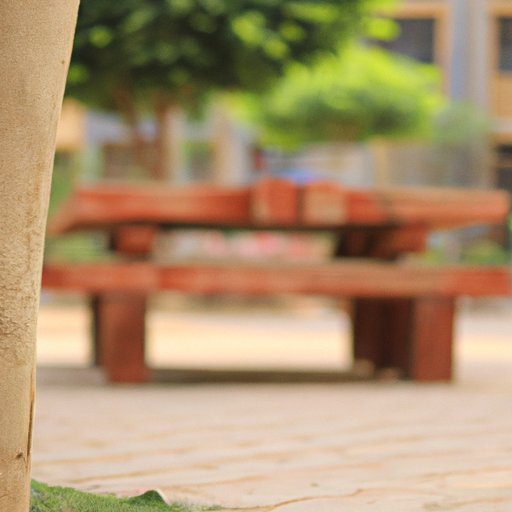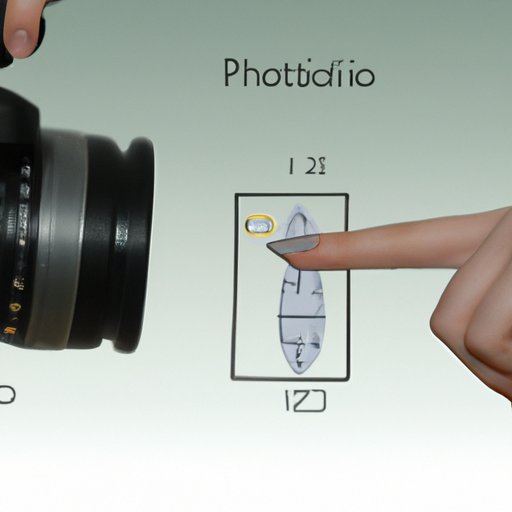Introduction
Photography is an art form that relies on several different elements to create stunning visuals. One of the most important components of any photograph is the focal point. Focal points are essential elements of a photo that catch the viewer’s attention and draw them into the scene. Knowing how to use focal points effectively can help you take your photography to the next level.
Definition and Role of Focal Points in Photography
A focal point is the main subject of a photograph. It is the element that stands out from the rest of the image and draws the viewer’s eye. Focal points can be any number of things, ranging from people to objects to landscapes. The key is to make sure the focal point is clearly visible and stands out from the rest of the image.
The role of the focal point is to guide the viewer’s attention through the image. This helps to create a cohesive composition and ensure that the viewer’s gaze is directed towards the subject of the photo. It also helps to add depth and dimension to the image, allowing the viewer to explore the entire scene.

Benefits of Understanding Focal Points
Understanding how to use focal points effectively can have a number of benefits for your photos. First, it allows you to draw the viewer’s attention to the subject of the photo. This can help to make your images more engaging and interesting. Second, it can help you to create a sense of depth and dimension in your images. By incorporating multiple focal points into the background and foreground of your images, you can create a dynamic, three-dimensional scene.
Finally, understanding focal points can help you to create visually pleasing compositions. By strategically placing focal points throughout the frame of your images, you can create a balanced, aesthetically pleasing shot. This can help to make your photos stand out from the crowd and capture the viewer’s attention.

How to Utilize Focal Points to Enhance Your Photos
Now that you understand the basics of focal points, let’s look at some tips for using them effectively to enhance your photos.
Creating Depth and Dimension with Focal Points
One of the most effective ways to use focal points is to create a sense of depth and dimension in your images. This can be done by incorporating multiple focal points into the background and foreground of your images. For example, if you are shooting a landscape, you can incorporate a person or object in the foreground to create a sense of depth. This will help the viewer to explore the entire scene and create a dynamic visual.
Tips for Successfully Composing Shots with Focal Points
In order to make your photos stand out, it is important to compose your shots carefully. Here are some tips for successfully composing shots with focal points:
- Focus on the subject—Make sure that the focal point is the main focus of the image. Try to avoid distractions and clutter.
- Create balance—When composing your shots, try to create a sense of balance and symmetry. This can help to make your photos more visually pleasing.
- Lead the eye—Use lines and other elements to lead the viewer’s gaze towards the focal point. This can help to create a stronger connection between the subject and viewer.
- Experiment with angles—Don’t be afraid to try different angles and perspectives. This can help to create a more interesting and unique image.

Choosing the Right Focal Point for Your Images
Once you have mastered the basics of composition, you can start to think about finding the right focal point for your images. There are a few factors to consider when choosing a focal point:
- Subject matter—Think about the type of subject matter you want to focus on. Is it a person, an object, or a landscape?
- Composition—Consider how the focal point fits into the overall composition of the image. Does it create a balanced, aesthetically pleasing shot?
- Context—Think about how the focal point relates to the context of the image. Does it help to tell the story of the image?
There are many different types of focal points you can use in your images. Here are some examples:
- People—Using people as focal points can help to create a sense of emotion and connection.
- Objects—Using objects as focal points can help to create a sense of scale and perspective.
- Landscapes—Using landscapes as focal points can help to create a sense of awe and beauty.
- Animals—Using animals as focal points can help to create a sense of energy and movement.
Conclusion
In conclusion, focal points are essential elements of any photograph. They are the main subjects of the image and help to guide the viewer’s attention. Knowing how to use focal points effectively can help you to create stunning visuals and take your photography to the next level. When choosing a focal point, consider the type of subject matter, composition, and context of the image. There are many different types of focal points you can use, ranging from people to objects to landscapes. With practice and experimentation, you can master the art of utilizing focal points in your photography.
Summary of Key Points
Focal points are essential elements of a photograph that draw the viewer’s attention and guide their gaze. Utilizing focal points effectively can help you to create stunning visuals and take your photography to the next level. When choosing a focal point, consider the type of subject matter, composition, and context of the image. There are many different types of focal points you can use, ranging from people to objects to landscapes.
Final Thoughts
Focal points are powerful tools that can help you to create compelling visuals. With practice and experimentation, you can learn how to use focal points effectively to enhance your photos. Keep these tips in mind and you’ll be able to capture stunning images in no time.
(Note: Is this article not meeting your expectations? Do you have knowledge or insights to share? Unlock new opportunities and expand your reach by joining our authors team. Click Registration to join us and share your expertise with our readers.)
